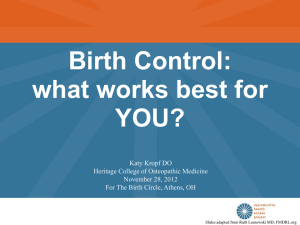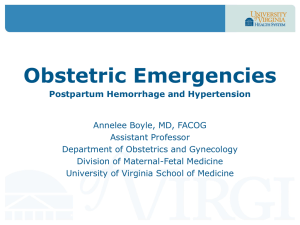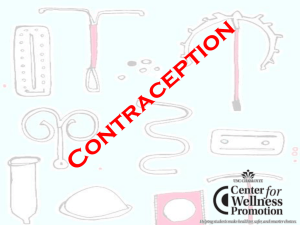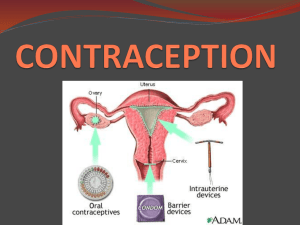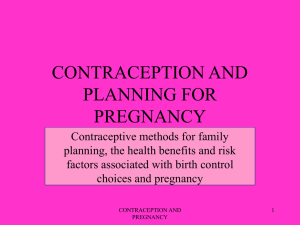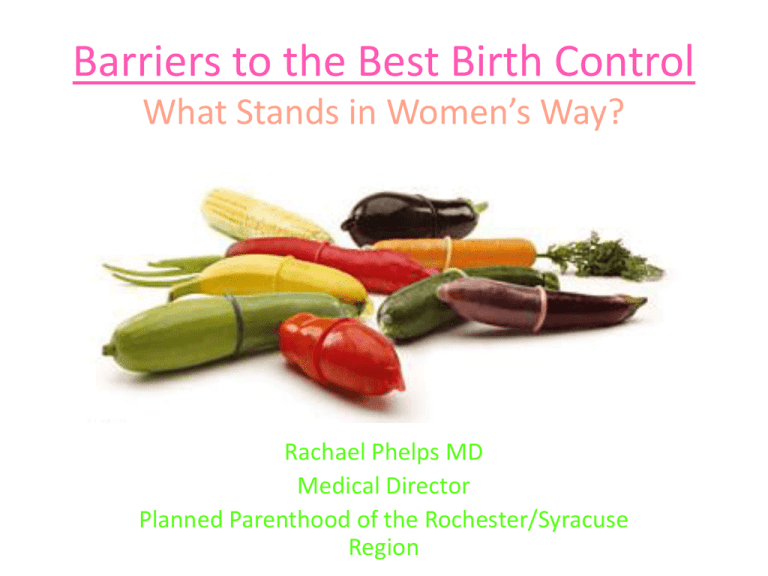
Barriers to the Best Birth Control
What Stands in Women’s Way?
Rachael Phelps MD
Medical Director
Planned Parenthood of the Rochester/Syracuse
Region
Unintended Pregnancy in the U.S.
6.7 million pregnancies
25%
51%
Births
Abortions
Miscarriage
49%
21%
3%
Intended
Pregnancy
Unintended
Pregnancy
Finer LB, Zolna, MR. Contraception. 2011.
UNFPA State of World
Populations 2011
Poverty: Growing Disparities
Overall unintended pregnancy
rates have plateaued, yet
disparities have increased
Women > 200% poverty line
Among poor women
Unintended pregnancy rates now
Finer, LB, Contraception 2011
5 TIMES HIGHER FOR POOR WOMEN
So the question is
WHY???
Women & Teens are not using the
most effective methods of
contraception
Effectiveness of Birth Control
Used by Contracepting Women
(U.S. women 15-44 yrs-CDC NSFG 2006-2008)
28%
27%
Extremely effective: >99%
Very effective: ~92%
Moderately Effective: ~85%
16%
5.50%
5.20%
3.20%
2.40%
p
la
n
t
in
g
P
at
c
h
/Im
R
ep
o
D
ra
w
l
W
it
h
d
D
IU
s
o
n
d
o
m
C
io
n
S
te
ri
liz
at
O
C
P
1%
Women Frequently Miss Pills
60%
51%
50%
40%
30%
20%
41%
37%
30%
33%
34%
30%
25%
19%
10%
0%
Correct Use
1-2 Missed Pills
Month 1
Month 2
3+ Missed pills
Month 3
Potter, L. et all. Family Planning Perspectives, 28:154-158, 1996
Long Acting Reversible Contraception
(LARC) = IUDs & Implants
QuickTime™ and a
decompressor
are needed to see this picture.
• Most effective methods: >99%
• Safest
– No estrogen
– Contraindications rare
• Highest patient satisfaction
– (80% LARC vs 50% short acting)
• Highest continuation rates
– (86% LARC vs. 55% short acting)
• Long-term protection last 3-12 years
• Rapid return of fertility
• Most cost effective
• Least likely to be used (5%)
Secura GM. The Contraceptive Choice Project. Am J Obstet Gyn. 2011.
Women & Teens are not using
the most effective methods of
contraception.
So the question is
WHY???
Why Are IUDs Underused?
• Lack of awareness of method
among women
• Myths & misconceptions
among women
• Myths & misconceptions
among providers
• Lack of physician training
• Expensive upfront cost
• Lack of insurance coverage
Weir E. CMAJ. 2003.; Stanwood NL, et al. Obstet Gynecol. 2002.
Steinauer JE, et al. Fam Plann Perspect. 1997.
Women lack basic knowledge
about contraception
$100 Million/Yr. for Abstinence Education
“the term ‘abstinence education’ means an
educational or motivational program which:”
•
•
“teaches that a mutually faithful monogamous relationship
in the context of marriage is the expected standard of sexual
activity;”
“teaches that sexual activity outside the context of marriage
is likely to have harmful psychological and physical side
effects;”
U.S. Section 510(b) of Title V of the Social Security Act
Teens Denied Accurate Information
Waxman, H. U.S. House of Representatives Report 2004
Condom
Misinformation
• “In heterosexual sex,
condoms fail to prevent HIV
approximately 31% of the
time.”
• “The popular claim that
‘condoms help prevent the
spread of STDs,’ is not
supported by the data.”
• “Pregnancy occurs 1/7 times
that a couple uses a
condom.”
Waxman, H. U.S. House of Representatives Report 2004
Gender Bias
“Just as a woman needs to feel a man’s devotion to her, a
man has a primary need to feel a woman’s admiration.
To admire a man is to regard him with wonder, delight
and approval. A man feels admired when his unique
characteristics and talents happily amaze her.”
Waxman, H. U.S. House of Representatives Report 2004
“5 major needs of women: financial support, family
commitment, affection, conversation, honesty and openness.”
“5 major needs of men: sexual fulfillment,
physical attractiveness, domestic support…”
Waxman, H. U.S. House of Representatives Report 2004
Lack of Sex Education
• 1 out of 5 unmarried
young adults say they
never had sex education
in school
• Of those who had it
more than 1 out of 4
had it before age 15
only.
Kaye, Kelleen et al.The Fog Zone.
The National Campaign to Prevent Teen and Unplanned Pregnancy 2009
Unmarried 18-29 year olds…
– 30% say they know little or
nothing about condoms
– 63% say they know little or
nothing about birth control
pills
– 56% say they have not heard
of the birth control Implant
– 90% believe they have all the
knowledge they need to avoid
an unplanned pregnancy
Kaye, Kelleen et al.The Fog Zone.
The National Campaign to Prevent Teen and Unplanned Pregnancy 2009
Among 18-29 y/o Condom Users….
More than 1 out of 4
did not know
how to use a
condom correctly!
– More than 1/3 believed it is ok to use vaseline or petroleum jelly
with condoms
– 1/4 believed wearing 2 condoms provides extra protection
– Almost half think condoms are as or more effective than the pill
(condom users twice as likely to get pregnant as pill users)
Kaye, Kelleen et al.The Fog Zone.
The National Campaign to Prevent Teen and Unplanned Pregnancy 2009
Seriously???
• Almost 1 in 5 young
adults believe douching
after sex can prevent
pregnancy
• Almost 1 in 5 young
men believe sex
standing up reduces the
risk of pregnancy
Kaye, Kelleen et al.The Fog Zone.
The National Campaign to Prevent Teen and Unplanned Pregnancy 2009
Young Pregnant Women
Lack Knowledge about IUDs
How safe/effective are IUDs compared to
pills, injections, or tubal sterilization?
Unsure of safety
71%
Unsure of efficacy
58%
Stanwood NL, et al. Obstet Gynecol. 2006.
Birth Control Myths
Women’s Misconceptions about the
Risk of Contraception Pose a
Significant Barrier to Use
• Unmarried young women (18-29)
– Half believed that using hormonal contraception for a
long period of time was likely to cause serious health
problems like cancer and this concern reduces their
likelihood of using pills or other hormonal methods.
– Among women who used OCP- almost half incorrectly
believed they should take a break from the pills every few
years
Kaye, Kelleen et al.The Fog Zone.
The National Campaign to Prevent Teen and Unplanned Pregnancy 2009
The Pill:
Misinformation
– 36% believed the pill is likely to cause weight gain and this
concern reduces their likelihood of using the pill.
– 40% believed the pill is likely to cause severe mood swings and
this concern reduces their likelihood of using the pill.
– 40% believed their chance of getting pregnant within a year of
using the pill is 50% or greater (actually 8% with typical use/ <1%
perfect use)
Kaye, Kelleen et al.The Fog Zone.
The National Campaign to Prevent Teen and Unplanned Pregnancy 2009
Common Myths About OCPs
Yale University Health Services’ study, 1991
Belief About OCs
% of Yale College
Students
OCs are associated with substantial risk
49%
OCs increase risk of breast cancer
47%
OCs increase risk of cervical cancer
29%
OCs increase blood pressure
19%
OCs cause heart disease or heart attack
9%
Peipert, Gutmann. Obstet Gynecol. 1993;82:112.
What Don’t Patients Know About
Health Benefits of OCPs
Yale
Brown
University University
% of patients who did not know that ...
19911
19952
OCs protect against ovarian cancer
80%
77%
OCs protect against endometrial cancer
80%
81%
OCs protect against ectopic pregnancy
88%
91%
OCs protect against PID
89%
90%
OCs protect against benign breast disease 95%
95%
OCs decrease dysmenorrhea
34%
75%
1. Peipert, Gutmann. Obstet Gynecol. 1993;82:112; 2. Tessler, Peipert. Women’s Health Issues.
1997;7:400.
Use Tools: Risk Comparisons
Annual risk of death (per 100,000)
Skydiving
100
Driving
20
Pregnancy
12
Riding a bicycle
0.8
Airplane crash
0.4
Using OCs*
0.06
*Nonsmoker, age 15–34
Bennett P. In: Risk Communication and Public Health. 1999; Chang J, et al. MMWR. 2003.
Harvard Center for Risk Analysis. 2006’ Schwingl PJ, et al. Am J Obstet Gynecol. 1999.
Trussell J, Jordan B. Contraception. 2006.
IUD Misinformation
– More than 1/2 believed IUDs are
likely to cause an infection and
this will make them less likely to
use method
– Almost 1/2 believed IUDs can
move around in a woman’s body
– 40% believed women must
undergo surgery for an IUD
– 1/4 young adults believed that an
IUD can’t be stopped early
Kaye, Kelleen et al.The Fog Zone.
The National Campaign to Prevent Teen and Unplanned Pregnancy 2009
Myths and Misconceptions Lead to
Discontinuation of BC
OR ELSE ……
Lack of EC Use…
•
•
•
•
•
Education
Misinformation
Access
Cost
Perceptions of
pregnancy risk
• Stigma of EC use,
particularly
multiple use
Emergency
Contraception
Without
a Prescription
France
1999
Sweden
Denmark
Portugal Belgium
Norway
U.K.
Finlan
d
2000
2001
2002
Latvia Switzerland
Canada
Estonia Netherland
s
2003
2004
2005
U.S.
(>18)
2006
U.S.
(>17)
200
9
What Can We Do
To Increase EC Use?
• Destigmatize Repeat or
Frequent Use and…
• Advance Provision!
• Advance Provision!
• Advance Provision!
5
Lack of Contraceptive Access for Teens
in School Clinics
90
80
70
60
50
40
30
20
10
0
Pregnancy
Testing
Condoms
EC
National Assembly on School-Based Health Care (NASBHC) 2000
Lack of Physician Training
Quick Start Method
Improving Contraceptive Initiation
• Start method today
(OCP, Ring, Patch, DMPA)
• If unprotected IC in past 5 days: Also offer EC
• Back-up for 7 days
QUICK START:
• Patients are more likely to start method
• Improves continuation rates
• Offers earlier protection from pregnancy
• No significant difference in the bleeding patterns compared
with menses start
Westoff C, Kerns J, Morroni C, et al. Contraception. 2002;66:141-5.
Initiation of Hormonal Contraceptives
Pregnancy test
Pelvic exam
Pap smear
STI screening
Leeman L. Obstet Gynecol Clin N Am. 2007
Reproductive
Coercion
Pregnancy Coercion
• Forced or pressured to get
pregnant
• Told not to use BC
• Threatened he would leave
if she does not get pregnant
• Said would have baby with
someone else
• Physical abuse because she
didn’t want to become
pregnant
Birth Control Sabotage
• Takes condom off during sex
• Puts holes in condom
• Breaks condom on purpose
• Takes away her birth control
• Keeps her from going to clinic
to get birth control
• Made her have sex without
condom
Reproductive Coercion
in Family Planning Clinics
• 1 in 5 reported pregnancy
coercion
• Almost 1 in 6 reported BC
sabotage
• > 1 in 3 reporting IPV
report reproductive
coercion
• Unintended pregnancy
rates were 42% higher in
women experiencing
reproductive coercion
Miller, E et al. Contraception April 2010
Lack of Insurance Coverage
and High Costs
Patient Protection & Affordable Care Act
HHS ASPE Issue Brief The cost of Covering Contraceptives through Health Insurance 2012
What Birth Control
Are Women Using?
56%
Extremely effective
Very effective
5.5%
LARC
Short Acting
U.S. women 15-44 yrs-CDC NSFG 2006-2008
What Birth Control
Would Women Choose?
70%
Extremely effective
Very effective
30%
LARC
Short Acting
Contraceptive Choice Project: Madden,T et al. Contraception 84 (2011)
What Birth Control
Are Teens Using?
69.4%
Extremely effective
Very effective
3.6%
LARC
Short Acting
U.S. teens 15-19 yrs-CDC NSFG 2006-2008
What Birth Control
Would Teens Choose?
62%
Extremely effective
Very effective
38%
LARC
Short Acting
Contraceptive Choice Project: Mestad, R et al. Contraception 84:2011.
Satisfaction with BC Method
100%
90%
80%
70%
60%
50%
40%
30%
20%
10%
0%
86%
82%
80%
78%
54%
52%
54% 52%
42%
h
tc
Pa
g
in
R
Ps
C
O
PA
M
D
on
an
D
pl
IU
Im
d
D
IU
g
in
ct
r
ga
na
ra
Pa
ire
M
ta
C
or
Sh
R
LA
Extremely effective (>99%)
Very effective (91% typical use)
Piepert JF et al. Obstet Gynecol May 2011
Continuation Rates at 1 Year
100%
90%
80%
70%
60%
50%
40%
30%
20%
10%
0%
88%
86%
84%
83%
57%
55%
54%
49%
h
tc
Pa
g
in
R
Ps
C
O
PA
M
D
on
an
D
pl
IU
Im
g
D
IU
rd
ga
na
ra
Pa
ire
M
in
ct
tA
C
or
Sh
R
LA
Extremely effective (>99%)
55%
Very effective (91% typical use)
Piepert JF et al. Obstet Gynecol May 2011
Thank You! Questions?
Fabulous Reproductive Health Resources
• www.arhp.org - Free webinars, great provider and patient
resources
• www.core.arhp.org - Evidence based downloadable slide sets
• www.prch.org/arshepdownloads - 13 downloadable power point
modules on adolescent reproductive health topics
• www.managingcontraception.com - Managing Contraception
pocket handbook
• www.plannedparenthood.org - Provider and patient resources
• www.cdc.gov/reproductivehealth/UnintendedPregnancy/
index.htm - Medical Eligibility Criteria for Contraception
• www.advocatesforyouth.org – Advocates for Youth
• www.guttmacher.org – Guttmacher Institute
• www.siecus.org - The Sexuality Information and Education Council
of the United States

